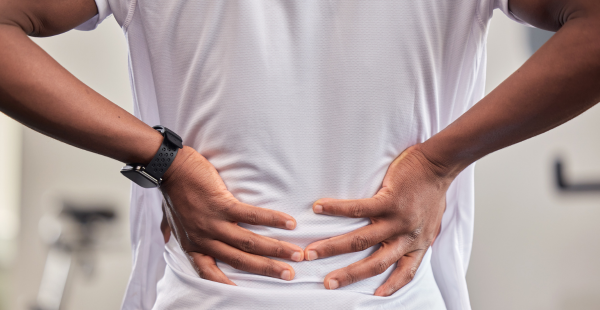The Facts
Low back pain is one of the most common reasons for visiting a doctor. Most North Americans will experience low back pain at some time in their lives. Back pain is costly to the health care system and is a common reason for time away from work.

The lower back consists of the vertebrae of the spine, muscles, and ligaments. The spine contains intervertebral discs, a kind of cushion made of cartilage that fits between 2 vertebrae (bone segments). Injury or disease of the muscles, ligaments, or discs of the lower back can cause back pain.
The risk of low back injury is higher for people who are overweight, have poor posture, or have weak back and abdominal muscles.
Causes
For most people with back pain, a specific cause can't be found. However, the most common cause of low back pain is muscle or ligament strains. If back pain comes on suddenly, it's usually a sign of a muscle tear, sprained ligament, or disc problem. A slipped disc occurs when pressure on a disc causes it to bulge or rupture, pushing cartilage sideways. The cartilage presses on the spinal cord nerves, causing intense pain.
Many conditions such as osteoporosis, osteoarthritis, fibromyalgia, ankylosing spondylitis, and spinal stenosis can cause back pain. Infections in the spine may also be a cause. Pregnancy can also cause back pain because of the extra body weight, changes in muscle and ligament firmness, and because the baby's head can compress the mother's spinal nerves. Overweight people are also more prone to back pain due to poorer posture and the extra strain that increased body weight places on discs and muscle.
Some medical problems (e.g., gallbladder disease, stomach problems) cause back pain. When pain is felt at a place in the body different from the injured or diseased part where the pain is expected to be, it is called "referred pain."
Although uncommon, there are some potentially serious causes of low back pain that don't involve injury to the back. These can include pneumonia, gallbladder disease, kidney infections, stomach problems (e.g., ulcer, appendicitis), abdominal aortic aneurysm, infection of the spine, or tumours.
Symptoms and Complications
Low back pain is a symptom itself of an underlying injury or problem. The type of pain depends on the cause. Low back pain can be mild or severe, or periodic or chronic. The pain can be deep, aching, stabbing, or throbbing. When a nerve is affected, the pain can radiate to different areas of the body, for example, down the leg, or to the ankle or foot.
Pain that's at its worst in the morning and gets better with movement and stretching is often an indication of muscle injury. If your low back pain is worse at night, and not relieved by exercise, it may be a sign of back pain "referred" to the back from some other organ or that it is due to a bone problem.
Pain that goes all the way down the back of one or both legs is a sign of sciatica. If the sciatic nerve, or some other spinal nerve, is being compressed, it may result in increased pain during coughing, sneezing, or straining. Another symptom of nerve compression is having difficulty raising your leg while keeping it straight. A slipped disc is a possible underlying cause of these symptoms.
Making the Diagnosis
It can be difficult to determine the exact cause of low back pain. Your doctor will ask you about your symptoms, including what the pain is like, how severe it is, and what things make it better or worse.
A search for the cause of back pain will involve a physical examination, including reflex and strength tests. If there's no obvious cause, X-rays, a computerized tomography (CT), or a magnetic resonance imaging (MRI) scan may be done to help find the cause. Your doctor may order other tests, depending on what he or she thinks may be other potential causes of your pain. It is very important to rule out any "red flags" that may indicate the potential presence of an underlying serious condition (e.g., infection, fracture, cancer, or inflammation) that needs prompt medical attention.
Be sure to see your doctor for evaluation if you have pain lasting more than 4 weeks or unexplained weight loss, or if you are over 50 years old and have new-onset pain.
Treatment and Prevention
The treatment of low back pain depends on its cause.
For low back pain involving muscle and nerves, treatment can include pain medications such as acetaminophen*, nonsteroidal anti-inflammatories (NSAIDs; e.g., ibuprofen, naproxen), or opioids (e.g., codeine) when pain is severe. Muscle relaxants (e.g., cyclobenzaprine, methocarbamol) may also be used, but their benefit in low back pain is not clear, and they have to be used with caution since they cause sedation. Heat and cold (for the first few days after an injury), treatments, and certain exercises as directed by a health care professional may also be used to help relieve pain. In some cases, chiropractic adjustments and physiotherapy can improve low back pain and disability.
Bed rest used to be recommended in the past, but current guidelines recommend that staying active can help speed up recovery. Avoid heavy lifting after an injury, but continue light activities. As well as losing weight, most people are advised to improve their posture or lift weights to strengthen the muscles and ligaments of the lower back. Strength training is a normal part of recovering from any muscle or ligament injury. Before starting an exercise program, discuss the activity first with your doctor and learn how to do the exercises properly.
Occasionally, slipped discs require surgery to decompress them. This may include deliberately fusing two vertebrae together. The operation shouldn't restrict back movement in any noticeable way.
Some back pain recurs over and over. Even the most thorough investigations may not find signs of injury or disease in some people. Speak to your doctor about exercises, physiotherapy, massage, or other therapies such as osteopathy, chiropractic, or manual physiotherapy.
You can help prevent low back pain by strengthening the muscles that support the back. Good posture while sitting or standing can also help prevent back pain. Proper lifting can also help prevent back injury: always keep the knees bent, do not twist the back, and use the legs to lift.
*All medications have both common (generic) and brand names. The brand name is what a specific manufacturer calls the product (e.g., Tylenol®). The common name is the medical name for the medication (e.g., acetaminophen). A medication may have many brand names, but only one common name. This article lists medications by their common names. For information on a given medication, check our Drug Information database. For more information on brand names, speak with your doctor or pharmacist.
All material copyright MediResource Inc. 1996 – 2025. Terms and conditions of use. The contents herein are for informational purposes only. Always seek the advice of your physician or other qualified health provider with any questions you may have regarding a medical condition. Source: www.medbroadcast.com/condition/getcondition/Low-Back-Pain



